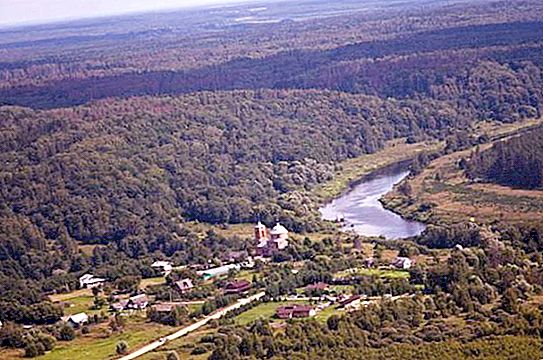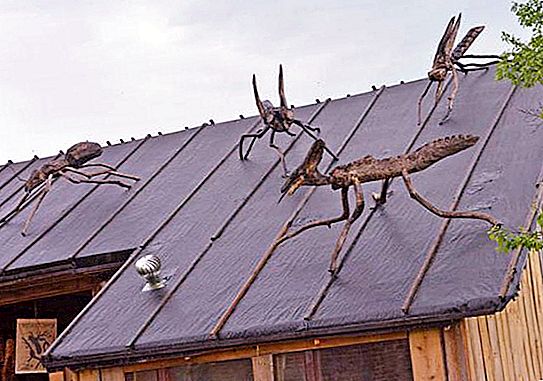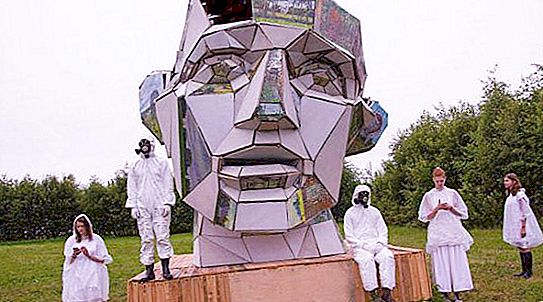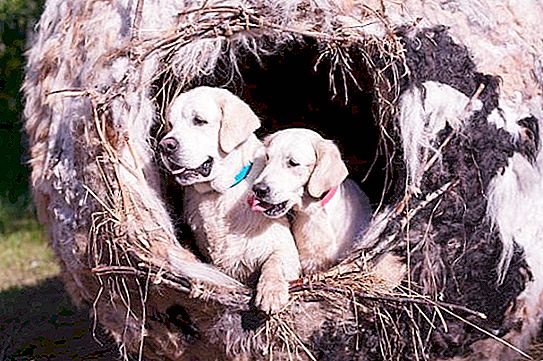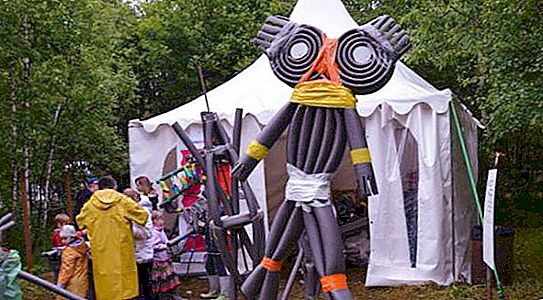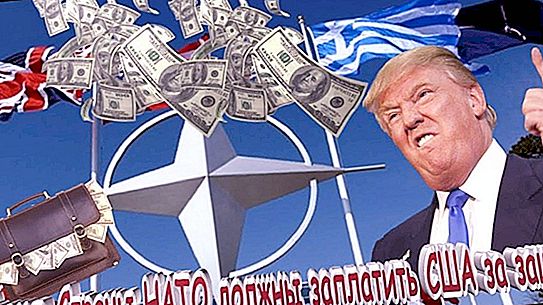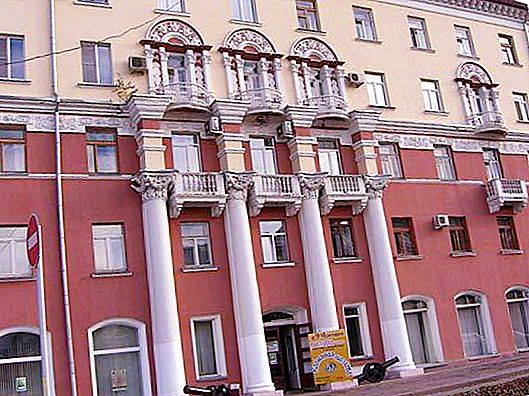The Archstoyanie festival has been held since 2006. The initiator and main inspirer of the event is the artist Nikolai Polissky. Over the eleven years of its existence, the festival has received the status of the largest land art event in Europe. Three projects are implemented during the year - two summer and one winter.
Village of Nikola-Lenivets
The village of Nikola-Lenivets is located on the banks of the Ugra River and has an ancient, glorious history. The name of the settlement is associated with a legend that says that on the eve of Nikolay-Ugodnik’s day, the village was attacked by enemy forces. It is not known which troops acted as invaders, but the villagers scattered around the neighborhood, and the enemies occupied the houses and indulged in joy from the joy of an easy victory. As a result of a violent feast, the military lost their vigilance (were lazy), and the village squad gathered together and defeated the enemy with dawn.
According to oral traditions, the name of the village appeared - Nikola (in honor of St. Nicholas the Wonderworker) Sloth (in memory of a brilliant victory over a frivolous enemy). Later, the settlement became an outpost on the path of many enemies, and in 1480, a historical event occurred near the village of Nikola-Lenivets - standing on the Ugra River, which put an end to the Tatar-Mongol yoke in Russia. The ancient village is a few kilometers from Moscow, and the nearest town is Kaluga.
Nikola-Lenivets has always been attractive to historians and archaeologists who unearthed ancient settlements, restoring the outline of the formation of Russian statehood. Today, the village enjoys increased popularity due to the annual festival, a huge natural and historical zone (650 hectares) with architectural objects within the Ugra National Park.
How did “Archstoyanie” appear?
At the turn of the 1980-1990s, at the next sharp turn in the history of the country, two architects Vasily Shchetinin and Yuri Grigoryan decided to leave the metropolis to find room for creativity. The search led to the village of Nikola-Lenivets, where at that time, only three residents lived. A little later, Nikolai Polissky joined the duet. For ten years, artists engaged in creativity, settled down and gradually transformed the space around the village.
The winter of 2000 became a breakthrough for Polissky - looking at the shores of the snowy Ugra, he imagined how snowmen would march along them. No sooner said than done. Local residents were involved in the modeling of the “snow army”, and soon the fantasy became a reality.
A photo session was exhibited in Moscow, and the first art objects made of natural materials began to appear in the Ugra National Park. In 2005, several sculptures were exhibited for public viewing - “Baikonur” was seen by metropolitan residents in the Tretyakov Gallery, the rest went to the halls of Venice, Zurich. The authors of the works went to popularize the Russian school of land art in Europe. Polissky, having visited the ArtKlyazma festival, finally became convinced that such an event was necessary on the Ugra.
First festival
The first festival "Archstoyanie" (Nikola-Lenivets) was held in 2006. According to the unofficial version, it was more like a rehearsal and a pleasant, but productive pastime for creative people. Polissky invited his friends, friends and just nice people to rest, and at the same time to practice the construction of objects from natural materials, which they had long thought of, but could not realize.
The event took place on July 29-30, about 500 people took part. In the manifesto of the first festival “Archstoyanie” it is said that the public is invited to visit the Forum, where it will be possible to get acquainted with the work of several architects, they will talk about their creations, and local residents will help to master some technologies of eco-design, tell how to independently build a hut, fold a woodpile, weave items from a birch forest and much more.
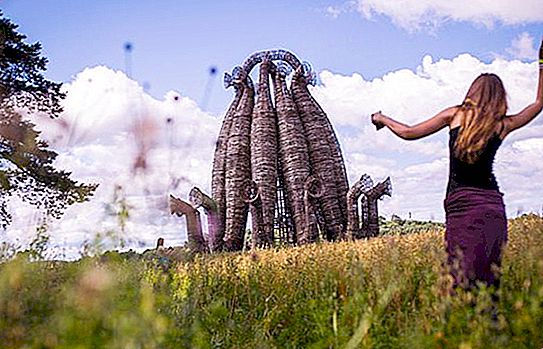
The first festival "Archstoyanie" was interesting to the authors and visitors themselves, the creativity in the format of land art from environmental materials was new and exciting. The program of the event included lectures, a round table on the theme “Five centuries of standing on the Ugra: the art of reconciliation”, where experts evaluated the possibilities of a new type of architecture in modeling, changing space, informal communication, a music program and much more.
Festival goals
The festival "Archstoyanie" (Nikola-Lenivets) is part of the surrounding space. Artists and architects in their works use only those materials that do not cause damage to nature, but when decaying, they add additional touches to the landscape. Over the life of the festival, more than 100 art objects have been created, more than 150 architects from around the world have become their authors.
Most of the sculptures are exhibited at various exhibitions, the remaining objects complemented the Ugra National Park. The annual event gives an impetus to the development of new forms of interaction between nature and art, there is a synthesis of landscape architecture, performance, new media, eco-farming and free creativity.
In its activities, the festival "Archstoyanie" (Nikola-Lenivets) pursues the following goals:
- The development of the territory, taking into account the preservation of its uniqueness with the help of modern practices in the socio-cultural, agricultural, artistic fields.
- Creating an ecological system for a new harmonious lifestyle.
- Search for new forms of modern architecture, landscape art and their development. Turning the place into an international expocenter of all types of art, architecture and eco-landscape.
Festival development
In subsequent years, the festival "Archstoyanie" (Nikola-Lenivets) gained momentum, gained scope and popularity.
Events held:
- 2007, August 4. The name "Border", the number of visitors - 1500 people. The forum was attended by landscape designer Adrian Gese.
- 2008, March 1. The third festival was held under the name “Noah's Ark”, 2500 people became its visitors.
- 2009, July 24-25. The slogan and philosophy of the event was the slogan “Out of the Earth!”. Over 3400 people took part.
- 2010, July 24-25. The name is “Nine Muses of the Labyrinth”, the number of visitors is 4000 people.
- 2011, July 29-31. The theme of the meeting is “Protosaray”, the number of visitors involved is 5500 people.
- 2012, July 27-29. The theme of the festival "Signs of Movement" brought together 6, 000 like-minded people.
- 2013, July 26-28. Ugra National Park hosted a festival called Out of the Forest. 6500 art culture lovers attended the event.
- 2014, July 25-27. The ninth festival was held under the name "Here and Now", the number of visitors - 9000 people.
- 2015, July 31 – August 2, the number of visitors - 9000 people, the name - “Zvizzhi”.
- 2016, July 22-24. The event hosted guests under the nostalgic name “Shelter”.
- 2017, July 21-23. This year's festival was held under the philosophical theme “How to live?”.
The brightest objects of 2017
This year, the creators and participants of the festival "Archstoyanie" (Nikola-Lenivets) wondered "How to live?" and made attempts to monetize creativity and created objects. Participants of the event recalled that architecture is an applied art that creates a living space.
Critics and guests highlighted some objects:
- "Kennel". The author of the work is Victoria Chupakhina. Participants were given assignments, one of them was the creation of a minimum space for life, which meets the principles of minimalism, environmental friendliness, harmonious combination with the natural landscape, reflects the lifestyle. The object represents a large ball made of branches and dog hair. Its internal volume is sufficient for a person and a dog. The kennel meets all the requirements - mobility, all-weather, comfort, coziness and the use of natural materials.
- The Wagon. The A-GA architectural bureau presented a mobile object created on the basis of the PAZ-3205 bus. It has all the conditions for living - a kitchen, shower. One of the walls is made of glass, illuminated from below by lamps and resembles a ramp, the sides are decorated with wings. Inside the “house”, during the festival, the actors staged the play “Three Sisters”.
- "House with a chandelier" is located on a floating platform and moored on the lake. The object consists of four plywood walls, above which a glass cube rises, and a classic-style chandelier is located in it. At night, its light resembles a lighthouse. The authors of the project are the Archbureau "Needles".
In addition to these works, many other conceptual projects were presented at the festival. For example, Alexei Martinez created one hundred small sculptures made of wood, which were burned on the first day of the festival, creating a large area of live fire. The project was called “Be Together” and really brought together all the participants and guests of the first day of the event.
Children's festival
In 2017, the children's festival “Archstoyanie” was held and the direction of Kaluga-Nikola-Lenivets became even more popular. Children independently answered the question “How to live?”, Showing imagination, originality and offering their own unbiased solutions. The organizers created several thematic platforms, offering to fantasize about the lives of athletes, monsters, book heroes, gardeners, architects, etc.
Many opportunities were provided for children's creativity - paints, brushes, books, places for games, reading and comprehension of the art of thinking, creating. Costume parades were organized, performances were shown with the involvement of a children's audience, those who wanted could listen to a game lecture on physics and chemistry, join a music salon and much, much more. According to parents, the children received a tremendous charge of vivacity, fun, expanded the horizons of knowledge and creativity.
Reviews about the festival
From year to year, the festival "Archstoyanie" (Nikola-Lenivets) is becoming increasingly popular. Visitors' comments about the sculptures are only enthusiastic. Those who have been to the event more than once, note a confidential, calm atmosphere, where there is no place for noisy showdowns, violent expression of emotions. But there is warmth, a general spirit of creativity and experimentation, long conversations or comfortable silence.
Fans of modern architecture and art land have long chosen the direction of Kaluga - Nikola-Lenivets and go there for the opportunity to observe changes in sculptures, relaxation, long, quiet transitions between art objects and of course for new items that appear in the park every year. In the active period, the park is visited by many curious people and the organizers took care of transport for faster movement - bicycles, they can be rented.
Guest reviews and recommendations
Visitors say that the opportunity to stay at the festival for several days has become much more comfortable - there is an infrastructure with hotels, a tent camp, a cafe, an eco-farm, with simple food from vegetables and fruits grown here. You can always settle with the locals for a small fee and at the same time get a delicious breakfast, a pleasant conversation. The natives of the village do not make secrets from their traditional crafts and are happy to educate everyone, for which a special platform has been created.
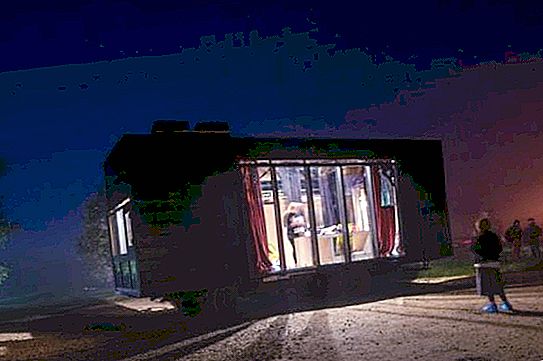
All objects of architecture and beauty of the National Park are available at any time, and not only during the Archstoyanie festival. Where this or that sculpture is located, the object realized and saved in the landscape, the locals will tell you, but it’s much more interesting to find them yourself, especially since many are impressive in size and visible from afar.
There are no negative reviews, but there are comments - the road to the park is poorly equipped, there are no signs indicating the distance to the next object, someone lacks souvenirs and almost all the prices for accommodation and meals seemed overpriced. In the recommendations, tourists are advised to be sure to arm themselves with insect repellents, come in comfortable shoes, count on long-distance walks, grab raincoats and rubber boots.
